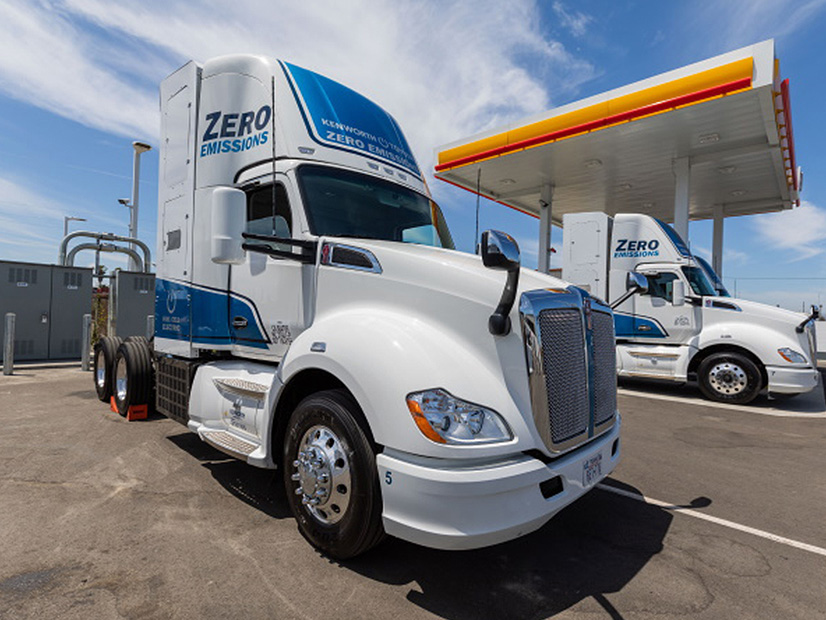
The California Public Utilities Commission last week increased the state’s multibillion-dollar commitment to transportation electrification by approving a $1 billion, five-year effort to provide charging infrastructure for electric vehicles.
Approximately 70% of the funds will be dedicated to charging medium- and heavy-duty vehicles; the rest will be for light-duty EV charging at or near multifamily housing complexes, with priority given to investments in low-income, underserved and tribal communities.
“This decision marks what I think is an important milestone in our role in promoting transportation electrification and achieving the state’s very ambitious climate goals,” said Commissioner Clifford Rechtschaffen, who led the effort. “Transportation emissions, as we often hear, are the state’s largest share of greenhouse gas emissions. They’re also responsible for the largest share of harmful air pollutants such as NOx, which causes ozone, and particulate matter, which has very harmful health effects.”
The 220-page decision adopting a Transportation Policy and Investment Plan also is meant to consolidate and streamline the CPUC’s efforts to fund transportation electrification by revamping the piecemeal approach it has taken in a dozen decisions since its first EV-funding rulemaking in 2009, Rechtschaffen said.
“The decision today results from over three years of hard work by staff and very engaged stakeholders,” he said. “Until now our electrification funding decisions came as a result of individual and really ad hoc applications for programs by each of the utilities. These programs weren’t especially well coordinated” and were often slow to win approval, requiring evidentiary hearings and long decision-making processes.
The CPUC has approved $1.8 billion over the years for “a whole host of utility programs, [including] light-duty and medium-duty market segments, workplaces, forklifts, school buses and many more. But as we gained more and more experience in this space, we thought it better to replace this ad hoc approach with something that’s more uniform, more streamlined and hopefully faster, and that’s what’s been developed here.”
Developments in state EV policy made funding programs more urgent, he said.
Gov. Gavin Newsom issued an executive order in September 2020 requiring that all new light-duty vehicle sales be zero-emission vehicles by 2035 and all new medium- and heavy-duty vehicle sales to be zero-emission by 2045. The California Air Resources Board adopted similar regulations in August as part of its Advanced Clean Cars program.
In October 2021, the CPUC, California Energy Commission (CEC) and the governor’s Office of Business and Economic Development met jointly to weigh the need for an additional 1.1 million light-duty public and shared EV chargers to meet the state’s transportation decarbonization goals, requiring a rapid acceleration in the spread of EV charging infrastructure by 2030.
An estimated 157,000 chargers will be needed for medium- and heavy-duty vehicles, the CEC found in its first Electric Vehicle Charging Infrastructure Assessment in July 2021.
The CPUC decision sought to address those needs through rebates for EV infrastructure.
“This decision adopts a long-term transportation electrification policy framework that includes a third-party-administered statewide transportation electrification infrastructure rebate program and directs the California electrical corporations, specifically, Pacific Gas and Electric, Southern California Edison [and] San Diego Gas & Electric … to jointly fund the program and associated activities,” the decision adopted Thursday said.
“The transportation electrification framework and rebate program further state policy promoting decarbonization and will continue to do so, as the supporting technology and policy mechanisms continue to mature,” it said.
In addition to the utility and ratepayer investments authorized by the CPUC, “billions of dollars in approved federal and state funds will support California’s [transportation electrification] infrastructure,” the decision said.
“As a result of the federal Infrastructure Investment and Jobs Act of 2021, for instance, California will receive $383 million in funding for [transportation electrification] infrastructure,” it said. “The act authorizes an additional $2.5 billion for ZEV infrastructure available in competitive grants nationwide.”
The CEC approved $1.4 billion for EV and hydrogen vehicle charging infrastructure over three years in November 2021.
And the past two state budgets committed a total of $10 billion to accelerate the state’s transition to ZEVs, with much of the funding dedicated to supporting medium- and heavy-duty fleets and disadvantaged and low-income communities. (See Calif. Governor Proposes Spending $10B on EVs.)
“California is leading the world in the zero-emission vehicle revolution, and this $1 billion investment will continue building out the state’s charging infrastructure to make the transition to electric vehicles easier than ever,” Gov. Gavin Newsom said in a statement following the decision.
“This complements the $10 billion package we enacted to build out the infrastructure and make it more affordable for Californians to make their own transition to electric vehicles, part of our overall $54 billion California Climate Commitment,” Newsom said. “These collective efforts are exactly how we will make our zero-emission transportation future a reality, cutting pollution and driving economic opportunity for Californians.”


